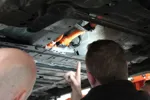The need to reduce CO2 emissions in automotive vehicles has, unsurprisingly, reached fever pitch in recent years.
On a global level governments have been tasked with meeting ever more stringent emission targets.
And truthful emissions recordings have become increasingly vital for consumers, who are facing higher fuel prices, and ever higher vehicle taxation throughout ownership.
The current CO2 testing procedure (NEDC) has long been unfit for purpose.
Organisations such as the ICCT have repeatedly demonstrated that the current NEDC lab tests do not reflect the actual behaviour of drivers in the real world - its limited duration and range of variables means it simply does not represent true driving.
So, the introduction of World Harmonized Light Vehicles Testing Procedure (WLTP) in September is an important step for the automotive industry, giving a more representative view of how people drive.
However, although it’s a step in the right direction, it doesn’t come without its challenges.
WLTP represents a significant data challenge for the automotive industry.
Once WLTP comes into force, every configurator that doesn’t calculate compliant numbers will become obsolete.
Overnight, the way that CO2 data is collected, managed and shared amongst interested parties will dramatically change, as any customer quotation will need to involve the effect of any accessories or options on emissions.
For leasing companies, providing WLTP compliant tax and pricing calculations for customers is a business continuity issue, but the ability to do this will depend on these organisations having access to accurate and compliant CO2 data from manufacturers.
This will involve vast data sets from multiple manufacturers so it is vital companies are prepared well in advance and have access to the correct data.
Therefore, ensuring the data is available in a single, industry-compliant location should be a high priority for all involved.
Failure to address the issue of data management and sharing could dramatically alter the relationship between leasing companies and manufacturers, and may affect the global automotive industry as a whole.
Against this backdrop of vast industry change, here are the four key things that manufacturers should be aware of ahead of the introduction of WLTP:
-
Think about the powertrain
Under the WLTP testing regime, the engine operating area for engine speed and load is higher than in the existing NEDC system. As a result, it may prove more difficult to reduce emissions on small petrol and diesel engines, which are increasingly common in the European market. Paying special attention to this group will be key to effectively reducing fleet average emissions.
-
Options are crucial
Each individual vehicle will have a WLTP CO2 value, depending on the fitment and composition of any added options that affect the mass, aerodynamics or tyre rolling resistance. This means additional source data will be required to calculate WLTP consequences of these different options. This includes what’s known as ‘high vehicle results and conditions’, and ‘low vehicle results and conditions’. As a result, for any vehicle family, the minimum and maximum CO2 levels will need to be tested so that all intermediate levels can be interpolated.
-
Labelling regulation will change
To ensure a smooth transition as the industry shifts from the current system (NEDC) to the future system of WLTP, labelling will be crucial and will be addressed at EU then country. The aim of the change is to make CO2 testing more representative of the real world, so CO2 values should be easily understood in labelling and easily comparable with the previous system to avoid confusion. Manufacturers should be aware of changes to the law and able to act on them quickly.
-
Implement a data procedure
Manufacturers must ensure that the leasing industry has access to the WLTP compliant CO2 emissions calculations that they need. Data sharing across the industry is obviously cumbersome and it’s impractical for leasing companies to manage this level of data individually.
Beyond the impending September deadline, there are a range of reasons why manufacturers should be directing their efforts towards reducing emissions in a cost-effective way as part of a long-term strategy, be that through the creation of alternative fuels or accessible hybrid engines.
But right now, the priority should be ensuring that data is shared and all those involved in the industry have access to compliant data.
In the longer term, WLTP will help stimulate innovation in the automotive sector by creating a market for technologies that improve fuel efficiency, but for now, the focus needs to be on getting prepared.
Not only will this cement the relationship between OEMs and leasing service providers, but it will ultimately protect the automotive industry.
Author: Jim Berriman (pictured), general manager at JATO Dynamics















Netscribes - 05/04/2017 07:41
Indepth and informative. Thankyou for your detailed views on this subject.